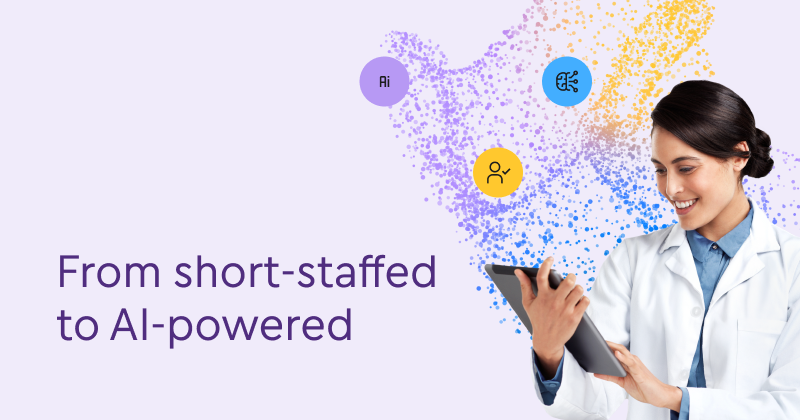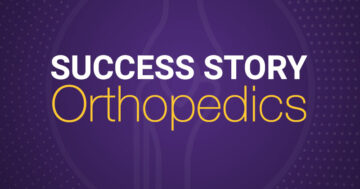How AI Can Help Medical Practices With Staffing Shortages

How can AI help your medical practice with the true cost of staff shortages?
Staffing shortages can create complex challenges for medical practices. When key positions remain unfilled, the impact goes beyond scheduling and workloads. Patient care and profitability may be at risk.
Artificial intelligence offers possible solutions, from analyzing patient and practice information to automating routine tasks and extending staff productivity. Emerging tools could help you work smarter, strengthen connections with patients and support financial predictability.
Keep reading to discover how AI could help support your team during a staffing shortage.
What happens when your staff is overworked?
Medical practices have experienced significant workforce shortages for several years. Additionally, projections show that in the near future there won’t be enough qualified staff to meet demand.
By 2036, the U.S. is projected to face a shortage of up to 86,000 physicians.1 The availability of nurses may vary by tens of thousands with a projected shortage of more than 346,000 nurses in 2027 and a slightly improved, but still challenging shortage of close to 208,000 in 2037.2
The hidden costs of medical staff shortages
If you’ve been dealing with this situation for a while, you may not notice the potential hidden costs of these shortages:
- Administrative burdens could lead to longer hours documenting, less time for patient interaction, slower billing cycles and higher risk of burnout
- Clinical impacts may include lower appointment availability, rushing through patient appointments and decreased patient satisfaction
- Financial consequences could include revenue loss, billing errors and omissions, staff overtime costs, higher patient attrition and lower patient acquisition
Left unaddressed, these challenges may compound, affecting your practice’s patient and staff retention, stability and growth potential.
Building practice resilience with AI
Fortunately, you may be able to offset these risks with AI tools that streamline operations and support productivity. Emerging AI solutions analyze information and can trigger automated tasks while keeping you in control of medical decisions and administrative approvals. These tools can help fill the gaps created by ongoing staffing shortages and increasing demands.
Patients may be ready for you to level up with artificial intelligence, too. A recent study shows that over half of patients surveyed would prefer AI in the doctor’s office if it leads to a better patient experience and more quality time with their providers. Patients felt most comfortable with AI handling administrative tasks like scheduling appointments and sending reminders (41%), supporting patient check-in (33%) and assisting with prescription refills (25%).3
While AI can prove valuable in reducing administrative burden, its benefits go beyond the back office. It can help create more opportunities for meaningful patient-doctor interactions — and 57% of patients said they prefer that their doctor’s office use AI for medical records documentation if it means more quality time with the provider during the appointment.3
Maintaining quality care even when you’re short on staff
If you’re looking for a simple way to integrate AI into your clinical workflows, consider using an ambient listening tool to aid with documentation during patient visits. These tools can free you up so you can devote more of your mental and emotional energy to the patient in front of you, helping you create meaningful connections, even when you’re busy and short-staffed.
What are ambient listening tools?
Ambient listening tools capture patient conversations and keywords without requiring you to click, tap or scroll. Similar to voice assistants on your personal devices, they process natural speech and suggest content for your clinical visit note.
When integrated into your EHR, an ambient listening tool may be able to extract medical terms, symptoms and treatment plans from natural conversation. You simply have to let it record the visit and review any suggested note content or transcriptions it generates. In some states and practices, you may need to confirm patient consent before you use an ambient listening tool.
The AI software listens and gathers information to suggest things like clinical histories, exam notes, impressions, plans, and E/M, ICD and CPT codes. Once the provider approves, the information populates the relevant sections in your visit note.
We know what you mean: ModMed® Scribe, our AI-powered ambient listening tool, understands the language of your specialty. It transforms patient conversations into visit notes and works with your EHR to trigger downstream clinical workflows.
Speeding up information exchange at the front desk
At some practices, leaders may try to stretch teams across different services in an attempt to get more done. But having people switch tasks and scramble all day is a recipe for burnout.
AI can help by handling routine tasks. For example, AI-powered fax solutions are designed to categorize incoming faxes and help link them to patient records. AI can also be used to route patient messages to designated team members-, which could help you improve response times.
These capabilities mean you can streamline some of your front desk’s most time-consuming tasks, giving them more time to focus on what really matters — connecting with patients.
Fax check: ModMed’s Enhanced Faxing AI tool could decrease the touch rate per fax for some providers from 15 to 20 human touchpoints to only four to five.
Take action to ease staffing challenges with AI
Even with projections indicating continued staff shortages, your practice could make headway with support from AI. New solutions are designed to help you keep up with administrative tasks and deliver timely, patient-focused care. With ambient listening tools and AI-powered communication systems, you are empowered to increase productivity across your practice. When integrated with your EHR, practice management system or patient engagement tool, these solutions can create even greater benefits, helping your whole team provide seamless patient care.
At ModMed we’re building well-trained AI solutions designed to reduce staff burnout, meet modern patient expectations and minimize administrative burdens.
Your AI-Powered Practice™ awaits. Schedule a demo today.
1 The Complexities of Physician Supply and Demand: Projections From 2021 to 2036. GlobalData Plc. Washington, DC. AAMC. 2024.
2 Health Workforce Projections. Department of Health and Human Services, Health Resources, and Service Administration.
3 ModMed Patient Experience Report: What Patients Think About AI at the Doctor’s Office. 2025. ModMed.
This blog is intended for informational purposes only and does not constitute legal or medical advice. Please consult with your legal counsel and other qualified advisors to ensure compliance with applicable laws, regulations and standards.
-







